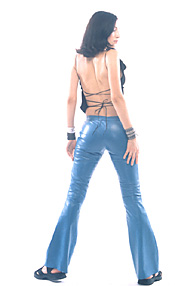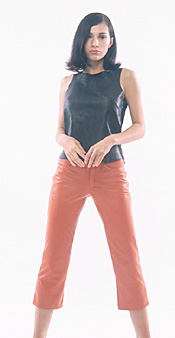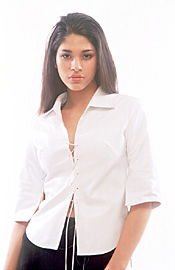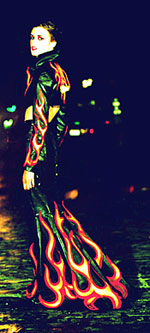
 |
Please write: dan@dancooper.tv
Return to Page One
Register here to receive Fashion Finds
email updates!
 |
FF: So how big a production staff do you have?
Carla Behrle: Actually, I have a very small one; it’s very bare bones. It’s me, and I have a seamstress full time, and I have other seamstresses that are on and off.
I do all the patterns, which makes my output a little bit less than I’d like it to be. But I’m really picky about the fit. And I think it pays off in the end. And I’m also picky about who I work with as far as my seamstresses. Because I’ve trained all of them to finish things the way I want.
And I won’t work with a contractor. And I mean at least at this point I haven’t found one that I could work with. I worked with a contractor when I first started, and it was disastrous. And that’s why I decided to just set up everything on my own.
FF: I think the perfect fit, and the detail, and all that you’ve put into it, is also what shows through in how beautiful everything is that you do.
Carla Behrle: Thanks a lot.
FF: It’s just exquisite. It’s really special. And was your first interest the actual medium that you use? Is it skins? Or was your first interest in designing?
Carla Behrle: Designing. I mean, when I was a kid I would draw on every available surface. From when I was probably two years old I used to start drawing things like shoes. I think I started with shoes. I had a shoe fixation.
And if I couldn’t find any paper I’d draw on the inside of drawers.
My mother’s house, all of the drawers are covered with felt now, and if you peel off the felt you’ll find these little drawings of these really primitive little high heel shoes. And then after shoes I’d start drawing like ladies and fancy costumes because I loved old movies. I grew up on the four-thirty movie when I was at home and there was school. And I would come home to watch the four-thirty movie.
FF: And what era and style of Hollywood movies were you most intrigued by?
Carla Behrle: Anything with period costumes. Period costumes, and then I got into a Mod Squad phase. Peggy Lipton.
 |
FF: And when you mention period costumes, is there any particular period that you were most fond of?
Carla Behrle: Well, I love the Directoire (influenced by Greco-Roman design, the Directoire was the style of the late 1790's in France, when women wore chemise gowns with low necklines and high waistlines --Gina) and the French Revolution era.
FF: Yes, I do too.
Carla Behrle: And it’s got such a really fascinating history, and the social history tied with the costumes. That’s also what really attracted me to costume, was the social part of it too. And that’s I think what really got me into fashion, was the reflection of the society. And the reflection of status and personality and livelihood. It was all reflected in the clothing.
FF: And so then you started designing women in costumes, and then how did you start refining it to the point where you started to make your own designs?
Carla Behrle: Well, I always made my own designs. I was always trying to make things either for myself, or I’d make something for my sister, or I would do a lot of Star Trek conventions. Whenever we had the opportunity me and my sister would get together and I’d do a costume for her, because she had like the perfect comic book Star Trek heroine type of body.
FF: Thin with big boobs, right.
Carla Behrle: Total comic book. I mean she actually modeled for a while.
And she was acting at the time. She and her boyfriend would like develop some story, and they’d do a little scene, a little script, we’d make up something. And then I’d do the costumes for it, and we’d go do the costume part of these conventions, Star Trek or science fiction conventions, or comic book conventions whichever one happened to be in the area.
And then we’d win prizes. Which is great.
FF: And who taught you how to sew?
Carla Behrle: My mom. I mean it started with my mom, and I took sewing classes and stuff when I was a kid.
And I basically learned probably most of what I know about sewing and production doing costumes.
Later I worked at the Shakespeare Festival in New York City (held every summer in Central Park –Gina).
FF: Aha.
Carla Behrle: Yeah, I worked there for a while.
FF: How wonderful.
Carla Behrle: Yeah. It was really wonderful -- it was a really good place to work. And I learned a lot. And that’s why I decided I wanted to work in leather.
 |
FF: Oh, okay, so let’s get to that. What happened between the conventions and the costuming for your sister and her boyfriend and stuff, and then the going to work for the Shakespeare company?
Carla Behrle: I always liked doing costumes. And I think I started doing those when I was like eleven. And then I did a couple of little community and dinner theaters.
And I did the costumes for several productions locally. And I guess that was the kind of crossover point. And then I worked for the Shakespeare Festival, and then after that, I worked in the garment center.
FF: I see. So you had made the move at that point to New York City.
Carla Behrle: Well, I’m actually from New Jersey. So it was never that far.
I was commuting back and forth. I took classes in New York at the same time I was finishing up high school.
The classes were for theatrical costume design at Lester Polakov’s, which doesn’t exist any more. It was a studio school for theatrical design.
It was a really wonderful studio school, and they taught set design and scenic painting and lighting and costume design. And it was specifically to get into the unions so you could work. And so I started going there while I was still in high school because they had classes for later in the day.
 |
And from there I started working for the Shakespeare Festival.
FF: And what was it about working at the Shakespeare Festival that really pointed the way, and you decided I’m going to work in leather? What was it about doing the costuming for that particular company?
Carla Behrle: Most of what I did there was I built the costumes. I wasn’t designing or anything; I was doing the construction. And so I got to work in like every kind of fabric and stuff. And I worked on what you have to work on. You work on whatever they hand you.
You’ve got to figure out how to build it. And so I was given something with leather trim. And then I was given something that was, you know, more leather. I just loved the way it handled. And I just really liked it. I mean I guess I had an affinity for it.
Because it’s not like fabric at all really, but the way I handle it, I kind of handle it like fabric. But the fitting’s very different than fabric; making the patterns is very different than fabric. They’ve really got to be precise. It’s not very forgiving when it’s on the body.
If it’s cut really well, you can actually make the most of the body.
FF: And so that’s how you use it like fabric; it’s the way you cut it.
Carla Behrle: I think the way I cut it, and the way I construct it. Because a lot of the construction techniques I’ve learned were more for fabric rather than like leather crafty type of construction techniques. Working at the Shakespeare Festival we worked in bias cut; we worked in everything. And with a really, really fine fabric. I learned how to finish things really well, and I put all that into my leather.
 |
I admire people who do leather very crafty, and less finished. Sometimes I try to force myself to do a little bit of that, because that’s important too. But I do it less. My look is a little more refined.
And even when I do something that’s got a lot of raw edges, I actually have several styles in the line that are very raw and rough; finishing I keep very fine. And I always try to keep the bulk down.
FF: I love the association with leather and armor. I don’t know if you saw the armor show at the Metropolitan Museum. I guess it was a year or so ago. And I was fascinated by the leather strapping, and the leather undergarments ...
Carla Behrle: All the articulation with the leather, yeah.
FF: ... is so beautiful. It’s really gorgeous. And so then when you left the Shakespeare Festival did you decide at that point you were going to start doing your own designs in leather and selling them?
Carla Behrle: What I wanted to do is I wanted to work in costume. So I went around and I sent my book to everybody I could in the costume industry. I’d gotten in the union, but I had no work under my belt with a union because I was also so young. It was impossible to get work, because at the time it seemed very much to me like a kind of old boys’ network. But then almost any industry I guess gets like that. They don’t want to work with you unless they know who you are, or that you’ve worked for them before, or that you’ve worked for somebody before.
So I just didn’t have the patience to go and work in wardrobe. Because I just didn’t feel like ironing clothes and dressing people. It wasn’t what I wanted to do at all, and so I started just doing freelance work, freelance designing in the fashion industry. I did kids’ wear. I did dance wear, sports wear type of stuff. I assisted another designer who did all different kinds of things.
Then the first major jobs that I got doing freelance, and the closest thing I got to leather, was gloves. I designed gloves. But then I exhausted all the glove companies in New York who design in this country. None of them had a place for a full time designer. And so I was working for all of them simultaneously until it became like a conflict they felt. And nobody wanted to pay me enough to live on.
So at that point I kind of was like okay, I got to do something on my own. So that’s what I did. I started doing custom work for customers. At first I did bolt fabric and leather. I actually did my share of wedding dresses. And which for a long time I couldn’t stop doing, because there were so many people asking for them. But I was doing the leather at the same time. I had started my line.
So I was working out of my apartment and doing leather and wedding dresses. So the last contact I had, I said to the woman, lookit, you’ve got to really plan ahead, because I’m not doing this otherwise. Because I’ve got this other business going on.
So she was great. She came to me a year in advance, with everything designed and all the fabrics picked out and everything, with ten months to go. And I was in full production with my line of leather which had taken off. And almost everything was black.
I was doing wholesale, and less custom, because I was really, really busy with the wholesale. Then I had another year that was like a bunch of bad experiences. And just the envisioning that the attitude in the business was just going to get worse.
So I just wanted to take a breather. Which is why I wanted to open the store.
Next, Pam Anderson makes an action movie and packs her
assets into Behrle leather....
